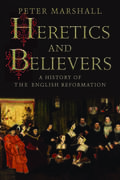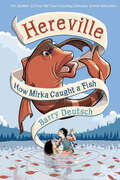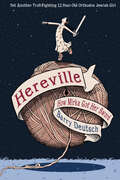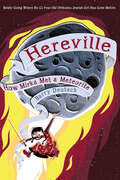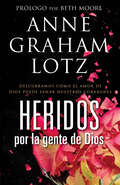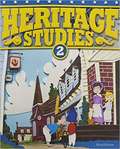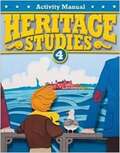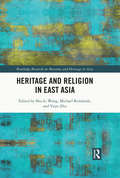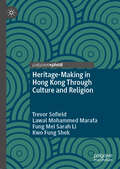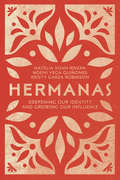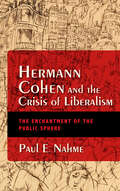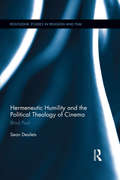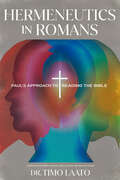- Table View
- List View
Heretics Anonymous
by Katie HenryPut an atheist in a strict Catholic school? Expect comedy, chaos, and an Inquisition. The Breakfast Club meets Saved! in debut author Katie Henry’s hilarious novel about a band of misfits who set out to challenge their school, one nun at a time. Perfect for fans of Becky Albertalli and Robyn Schneider. <P><P> When Michael walks through the doors of Catholic school, things can’t get much worse. His dad has just made the family move again, and Michael needs a friend. When a girl challenges their teacher in class, Michael thinks he might have found one, and a fellow atheist at that. Only this girl, Lucy, isn’t just Catholic . . . she wants to be a priest. <P><P>Lucy introduces Michael to other St. Clare’s outcasts, and he officially joins Heretics Anonymous, where he can be an atheist, Lucy can be an outspoken feminist, Avi can be Jewish and gay, Max can wear whatever he wants, and Eden can practice paganism. <P><P>Michael encourages the Heretics to go from secret society to rebels intent on exposing the school’s hypocrisies one stunt at a time. But when Michael takes one mission too far—putting the other Heretics at risk—he must decide whether to fight for his own freedom or rely on faith, whatever that means, in God, his friends, or himself.
Heretics and Believers: A History of the English Reformation
by Peter MarshallA sumptuously written people’s history and a major retelling and reinterpretation of the story of the English Reformation Centuries on, what the Reformation was and what it accomplished remain deeply contentious. Peter Marshall’s sweeping new history—the first major overview for general readers in a generation—argues that sixteenth-century England was a society neither desperate for nor allergic to change, but one open to ideas of “reform” in various competing guises. King Henry VIII wanted an orderly, uniform Reformation, but his actions opened a Pandora’s Box from which pluralism and diversity flowed and rooted themselves in English life. With sensitivity to individual experience as well as masterfully synthesizing historical and institutional developments, Marshall frames the perceptions and actions of people great and small, from monarchs and bishops to ordinary families and ecclesiastics, against a backdrop of profound change that altered the meanings of “religion” itself. This engaging history reveals what was really at stake in the overthrow of Catholic culture and the reshaping of the English Church.
Heretics: The Creation of Christianity from the Gnostics to the Modern Church
by Jonathan WrightA lively examination of the heretics who helped Christianity become the world&’s most powerful religion. From Arius, a fourth-century Libyan cleric who doubted the very divinity of Christ, to more successful heretics like Martin Luther and John Calvin, this book charts the history of dissent in the Christian Church. As the author traces the Church&’s attempts at enforcing orthodoxy, from the days of Constantine to the modern Catholic Church&’s lingering conflicts, he argues that heresy—by forcing the Church to continually refine and impose its beliefs—actually helped Christianity to blossom into one of the world&’s most formidable religions. Today, all believers owe it to themselves to grapple with the questions raised by heresy. Can you be a Christian without denouncing heretics? Is it possible that new ideas challenging Church doctrine are destined to become as popular as Luther&’s once-outrageous suggestions of clerical marriage and a priesthood of all believers? A delightfully readable and deeply learned new history, Heretics overturns our assumptions about the role of heresy in a faith that still shapes the world. &“Wright emphasizes the &‘extraordinarily creative role&’ that heresy has played in the evolution of Christianity by helping to &‘define, enliven, and complicate&’ it in dialectical fashion. Among the world&’s great religions, Christianity has been uniquely rich in dissent, Wright argues—especially in its early days, when there was so little agreement among its adherents that one critic compared them to a marsh full of frogs croaking in discord.&” —The New Yorker
Hereville: How Mirka Caught a Fish
by Barry DeutschThe Orthodox Jewish heroine of Hereville must save her sister from a malevolent magic fish in this “consistently clever” preteen graphic novel series (Kirkus).Welcome back to Hereville, where Mirka, the world’s first time-traveling, monster-fighting Orthodox Jewish girl, faces her greatest challenge yet: babysitting! Mirka just wants to find new adventures, but instead she’s stuck babysitting her disapproving little sister, Layele. When Mirka pushes her sister into a stream, they both get in too deep with an angry magic fish. No matter how hard Mirka fights this fish-out-of-water, it gets stronger and stronger—and it’s out for revenge. Mirka is in over her head, and this time, her whole family is on the line! When the fish kidnaps Layele, Mirka must find a way to save her little sister, and the clues she needs are hidden in her stepmother Fruma’s past. Mixing fantasy, adventure, cultural traditions, squabbling siblings, and preteen commotion, Hereville: How Mirka Caught a Fish is sure to captivate readers with its exciting visuals and indomitable heroine.
Hereville: How Mirka Got Her Sword (Hereville)
by Barry DeutschA young Orthodox Jewish girl embarks on a fantastical adventure in this acclaimed graphic novel for preteens—“a terrific story, told with skill” (Publishers Weekly, starred review).Spunky, strong-willed eleven-year-old Mirka Herschberg isn’t interested in knitting lessons from her stepmother, or how-to-find-a-husband advice from her sister, or you-better-not warnings from her brother. There’s only one thing she does want: to fight dragons!Granted, no dragons have been breathing fire around Hereville, the Orthodox Jewish community where Mirka lives. But that doesn’t stop the plucky girl from honing her skills by fearlessly stands up to local bullies. She battles a very large, very menacing pig. But when she boldly accepts a challenge from a mysterious witch, Mirka might finally get her very own dragon-slaying sword! All she has to do is find—and outwit—the giant troll who’s got it!A delightful mix of fantasy, adventure, cultural traditions, and preteen commotion, Hereville will captivate middle-school readers with its exciting visuals and entertaining new heroine.
Hereville: How Mirka Met a Meteorite (Hereville)
by Barry DeutschIn this “truly clever” graphic novel series, the Orthodox Jewish heroine of Hereville meets her match—a magical doppelgänger of herself (Kirkus, starred review).Mirka is back, and she’s still the only sword-brandishing, monster-fighting Orthodox Jewish girl in town. Or so she thinks. When a misguided troll aims a meteor at Hereville, the local witch grabs the closest thing available to transform the flying, flaming rock—and that would be Mirka’s hair. The meteor is changed, all right: it’s now Mirka’s identical twin. Doppelganger Mirka, vowing to be a better version of the real girl, sets out to charm all of Hereville, including Mirka’s own family. Our heroine challenges the meteor girl to a three-part contest . . . and the loser will be banished from Hereville forever!A delightful mix of fantasy, adventure, cultural traditions, and preteen commotion, this fun, quirky graphic novel series will captivate middle-school readers with its exciting visuals and entertaining new heroine.
Heridos por la gente de Dios: Descubramos cómo el amor de Dios puede sanar nuestros corazones
by Anne Graham LotzHeridos por la gente de Dios.... Sanados por el amor de Dios Todo el mundo ha sido herido… dañado… descuidado… por otros. Pero cuando Anne Graham Lotz hace una retrospeción de su vida, la triste verdad es que sus heridas más dolorosas le fueron infligidas por personas religiosas: pueblo de Dios. Personas a quienes había aprendido a amar y en quienes confiaba. Pero gente cuyas palabras y conducta eran incompatibles con lo que decían creer. Anne no solo comprende a los heridos, también comprende cuán fácil es para los heridos convertirse a su en vez heridores. En este libro, Anne rompe el silencio de los heridos y de los heridores, para quebrar el ciclo de dolor. Basándose por la historia bíblica de Agar, Anne lleva a quienes han sido heridos por gente de Dios por un camino donde descubrirá el poder sanador del amor redentor de Dios. Este libro es una historia de amor… ¡la suya!
Heritage Studies 2
by Bju PressThis book is an easy-to-read presentation of social studies that integrates civics, culture, economics, geography, and history.
Heritage Studies 3 Third Edition
by Brian C. CollinsHeritage Studies 3 includes an age-appropriate study of civics and government and evaluates historical events in United States history from the Constitutional Convention through the Civil War, all from a Christian world view.
Heritage Studies 4, Third Edition
by Bju PressHeritage Studies 4, 3rd ed., is a colorful, age-appropriate presentation of social studies that integrates government, culture, economics, and geography, all presented from a Christian worldview.
Heritage Studies 4: Student Activity Manual
by Bju PressHeritage Studies 4 Student Activities Manual, 3rd ed., provides full-colored pages that reinforce and enrich the lessons. Activities include graphic organizers, reinforcement pages, map skills, study skills, Bible connections, study guides, and chapter reviews. Primary Source documents are also included for some of the chapters.
Heritage Studies 5 (3rd Edition)
by James R. Davis Peggy S. Alier Annittia Jackson Lori Weir Debra WhiteHistory and geography both help us understand the world around us. History is the study of the past. Geography is the study of place. Geography helps us learn not only where places are but also how they differ and why.
Heritage Studies 5, Fourth Edition
by Annittia Jackson Brian C. Collins Eileen Berry Ethan BirneyBJU Press Heritage Studies 5 presents the narrative of American history from the creation of the car in the late 1800s through the 2015 Clean Power plan. Photographs, illustrations, maps, timelines, and notes highlight themes of geography, American history, government, economics, world history, and culture. Topics are presented from a biblical perspective and include the invention and influence of the automobile and airplane, World War I, the Roaring Twenties, the Great Depression, World War II, the Vietnam War, struggles over civil rights, the war on terror, Afghanistan and Iraq wars, and immigration decisions, all from a Christian worldview. This study highlights the role of significant Christians in American history and their viewpoints on historical events. This resource is also known as Bob Jones Heritage Studies Grade 5 Text, 4th Edition.
Heritage Studies 6 Activity Manual (3rd Edition)
by James R. Davis Peggy S. Alier Annittia Jackson Debra White Marnie Batterman Eileen M. Berry Ann L. Carruthers Laurie Tebbenkamp Dennae WhiteThe American Republic provides students with a survey of the history and heritage of the United States from Christian worldview.
Heritage Studies Student Grade 1, Third Edition
by Eileen Berry Gina Bradstreet Ann Larson L. Michelle RosierThe book examines the events from pre-1000 to 1682, covering Columbus, Plymouth, trading, Native Americans and other colonial events through the lens of God's redemptive plan.
Heritage and Its Missions: Contested Meanings and Constructive Appropriations (Catholic Practice in the Americas)
by Cristóbal Gnecco and Adriana Schmidt DiasExplores how heritage discourses and local publics interact at Catholic mission sites in the southwestern United States, northern Mexico, and the Southern ConeInterdisciplinary in scope and classed under the name “critical heritage studies,” Heritage and Its Missions makes extensive use of ethnographic perspectives to examine heritage not as a collection of inert things upon which a general historical interest is centered, but as a series of active meanings that have consequences in the social, political, and economic arenas. This approach considers the places of interaction between heritage discourses and local publics as constructed spaces where the very materiality of the social and the political unfolds.Heritage and Its Missions brings together researchers from several countries interested in the pre-republican Catholic missions in the Americas as heritage. Each essay discusses the past and current heritage meanings applied to a specific mission by national and multicultural states, local Indigenous and non-Indigenous communities, international heritage institutions, and scholars. They then address how heritage actors produce knowledge from their positioned perspectives; how different actors, collectives, communities, and publics relate to them; how heritage representations are deployed and contested as social facts; and how different conceptions of “heritage” collide, collaborate, and intersperse to produce the meanings around which heritage struggles unfold.
Heritage and Religion in East Asia (Routledge Research on Museums and Heritage in Asia)
by Yujie Zhu Michael Rowlands Shu-Li WangHeritage and Religion in East Asia examines how religious heritage, in a mobile way, plays across national boundaries in East Asia and, in doing so, the book provides new theoretical insights into the articulation of heritage and religion. Drawing on primary, comparative research carried out in four East Asian countries, much of which was undertaken by East Asian scholars, the book shows how the inscription of religious items as "Heritage" has stimulated cross-border interactions among religious practitioners and boosted tourism along modern pilgrimage routes. Considering how these forces encourage cross-border links in heritage practices and religious movements in China, Taiwan, South Korea, and Japan, the volume also questions what role heritage plays in a region where Buddhism, Taoism, and other various folk religious practices are dominant. Arguing that it is diversity and vibrancy that makes religious discourse in East Asia unique, the contributors explore how this particularity both energizes and is empowered by heritage practices in East Asia. Heritage and Religion in East Asia enriches understanding of the impact of heritage and religious culture in modern society and will be of interest to academics and students working in heritage studies, anthropology, religion, and East Asian studies.
Heritage, Pilgrimage and the Camino to Finisterre
by Cristina Sánchez-CarreteroThis book presents research concerning the effects of the Camino to Finisterre on the daily lives of the populations who live along the route, and the heritagization processes that exploitation of the Camino for tourism purposes involves. Rather than focusing on the route to Santiago de Compostela and the pilgrimage itself, it instead examines a peculiar part of the route, the Camino to Finisterre, employing multiple perspectives that consider the processes of heritagization, the effects of the pilgrimage on local communities, and the motivations of the pilgrims. The book is based on a three-year research project and is the result of a multidisciplinary collaboration between anthropologists, sociologists, historians and archaeologists. Instead of ending in Santiago, as the rest of the Caminos do, this route continues to the cape of Finisterre on the Galician Atlantic coast. This part of the Camino de Santiago is not officially recognized by the Catholic Church and does not count as part of reaching Compostela, the recognition granted by the Catholic Church to those pilgrims who have walked at least 100 km. For this reason, as well as its relationship with the sun cult, many pilgrims call this route "the Camino of the atheists. " In fact, the Catholic Church is a strong force for the heritagization of the rest of the Caminos, and maintains a clear ignoratio strategy concerning the Finisterre route: Officially, the church neither opposes nor recognizes this route.
Heritage-Making in Hong Kong Through Culture and Religion
by Trevor Sofield Lawal Mohammed Marafa Fung Mei Li Kwo Fung ShekThis book centres on religious heritage-making where religion as a rich and diverse manifestation of culture and community empowerment lead to the transformation of place. Fusing heritage and religion in the novel multidisciplinary concept ‘heri-ligion’, the authors illuminate the dynamics of change inherent in religious-oriented heritage-making. Grounded in empirical evidence, this rich concept integrates religious tourism, heritage tourism, and community-based empowerment for sustainable development. Applying this unique concept to the once abandoned Hakka village of Yim Tin Tsai, the authors analyse the evolving paths of the island from its Hakka origins to a Christian pilgrimage site, and more recently, to a UNESCO cultural heritage site and thriving tourist destination. The authors foreground the important role of the scattered community as a key agent of change in facilitating a sustainable environment of Hong Kong’s only salt-producing place today. A dynamic example of community development and empowerment founded upon religious, cultural, industrial and natural heritage, this book uniquely contributes to tourism and heritage studies, human geography, cultural sociology, Hakka studies, Asian studies, and anthropology of religion.
Hermanas: Deepening Our Identity and Growing Our Influence
by Natalia Kohn Rivera Noemi Vega Quiñones Kristy Garza RobinsonGod calls Latinas to lives of influence. He created his Latina daughters to partner with him, live into the incredible plans he has for each of us, and walk in his grace and strength to help change this world. But many of us have heard cultural messages that make us doubt our adequacy. We have not seen many Latina women in positions of leadership, and we need more mentors and role models. Natalia Kohn, Noemi Vega Quiñones, and Kristy Garza Robinson share their own journeys as Latinas and leaders. They find mentorship in twelve inspirational women of the Bible including Esther, Rahab, Mary, and Lydia, who navigated challenges of brokenness and suffering, being bicultural, and crossing borders. As we deepen our spiritual and ethnic identities, we grow in intimacy with God and others and become better equipped to influence others for the kingdom. The insights here will help any who seek to empower Latinas in leadership. You are not alone on this journey. Join your sisters and partner with our heavenly Father as you become the Latina leader God has called you to be.
Hermann Cohen and the Crisis of Liberalism: The Enchantment of the Public Sphere (New Jewish Philosophy and Thought)
by Paul E. NahmeHermann Cohen (1842–1918) is often held to be one of the most important Jewish philosophers of the nineteenth century. Paul E. Nahme, in this new consideration of Cohen, liberalism, and religion, emphasizes the idea of enchantment, or the faith in and commitment to ideas, reason, and critique—the animating spirits that move society forward. Nahme views Cohen through the lenses of the crises of Imperial Germany—the rise of antisemitism, nationalism, and secularization—to come to a greater understanding of liberalism, its Protestant and Jewish roots, and the spirits of modernity and tradition that form its foundation. Nahme’s philosophical and historical retelling of the story of Cohen and his spiritual investment in liberal theology present a strong argument for religious pluralism and public reason in a world rife with populism, identity politics, and conspiracy theories.
Hermann Cohen and the Crisis of Liberalism: The Enchantment of the Public Sphere (New Jewish Philosophy and Thought)
by Paul E. NahmeA fresh look at a nineteenth-century Jewish philosopher whose theology offers a beacon in an illiberal twenty-first century world: “Recommended.” —ChoiceHermann Cohen is often held to be one of the most important Jewish philosophers of the nineteenth century. Paul E. Nahme, in this new consideration of Cohen, liberalism, and religion, emphasizes the idea of enchantment, or the faith in and commitment to ideas, reason, and critique—the animating spirits that move society forward.Nahme views Cohen through the lenses of the crises of Imperial Germany—the rise of antisemitism, nationalism, and secularization—to come to a greater understanding of liberalism, its Protestant and Jewish roots, and the spirits of modernity and tradition that form its foundation. Nahme’s philosophical and historical retelling of the story of Cohen and his spiritual investment in liberal theology present a strong argument for religious pluralism and public reason in a world rife with populism, identity politics, and conspiracy theories.
Hermaphrodites, Gynomorphs and Jesus
by David C. HillmanThe first western god was both male and female. All of western religion springs from the veneration of a bi-gender entity, known to the ancient world as the Gynomorph. The worship of hermaphroditic gods like the Gynomorph surfaces in ancient pagan cults as well as early Christianity.The celebration of female gods with penises impacted the development of western culture. Veneration of the Gynomorph is the basis for modern western law courts. The founders of democracy worshipped similar female divinities who possessed penises. Ritual sodomy as a means of celebrating hermaphroditic gods directly promoted the birth of western democracy. In fact, ancient priestesses responsible for guiding the worship of hermaphroditic goddesses laid the very foundations for democracy, science and philosophy.The oldest western pharmaceuticals were sex drugs used in religious initiations in celebration of the Gynomorph. Snake venoms used in cultic sex rituals were immensely popular in both Greece and Rome. In addition, abortion-inducing drugs promoted the first scientific investigations. Classical civilization relied heavily upon the use of cannabis, opiates, and hallucinogens, which were mixed with sexual stimulants. Greco-Roman witches, who served a prominent hermaphroditic goddess, Hecate, were among the earliest western scientists and naturalists.Devotees of gynomorphic divinities were the first westerners to promote the religious practice known as necromancy. The first "baptists" were cross-dressing necromancers, who celebrated the Gynomorph. Eunuchs who served the same goddess were chemically castrated with scorpion venom. Ancient pre-Christian oracles declared that the messiah must be a hermaphrodite. Christianity tried to assimilate and employ the use of necromancy. The earliest Christians used designer sex drugs in their rituals in order to venerate a messiah given gynomorphic status by church bishops.
Hermeneutic Humility and the Political Theology of Cinema: Blind Paul (Routledge Studies in Religion and Film)
by Sean DesiletsThis book revisits the tradition of Western religious cinema in light of scholarship on St. Paul’s political theology. The book’s subtitle derives from the account in the Book of Acts that St. Paul was temporarily blinded in the wake of his conversion on the road to Damascus. In imitation of Paul, the films on which Sean Desilets’s analysis hinges (including those of Carl-Th. Dreyer, Robert Bresson, Pier Paolo Pasolini, and Carlos Reygadas) place a god-blind mechanism, the camera, between themselves and the divine. Desilets calls the posture they adopt "hermeneutic humility": hermeneutic in that it interprets the world, but humble in that it pays particular—even obsessive—attention to its own limits. Though these films may not consciously reflect Pauline theology, Desilets argues that they participate in a messianic-hermeneutic tradition that runs from Paul through St. Augustine, Blaise Pascal, Karl Barth, and Walter Benjamin, and which contributes significantly to contemporary discussions in poststructuralist literary theory, political theology, and religious studies. Desilets’s insightful explication of Jean-Luc Nancy’s deconstruction of Christianity and Georgio Agamben’s recent work on religion makes a substantial contribution to film philosophy and emerging critical trends in the study of religion and film. This book puts forward a nuanced theoretical framework that will be useful for film scholars, students of contemporary political theology, and scholars interested in the intersections of religion and media.
Hermeneutics in Romans: Paul's Approach to Reading the Bible
by Timo Laato Bror Erickson Kristina Odom Weslie Odom"And behold, a lawyer stood up to put him to the test, saying, "Teacher, what shall I do to inherit eternal life?" He said to him, "What is written in the Law? How do you read it?" (Luke 10:25-26)Eternal life is found within the pages of Holy Scripture, both in the Old Testament Torah referred to as "the Law" in this exchange between Jesus and the lawyer, and in the New Testament written in the wake of Christ's resurrection. But as Jesus points out, it matters how you read Holy Scripture, and this is where the art of hermeneutics, the study of interpretation, makes its entrance. In Hermeneutics in Romans, Dr. Timo Laato returns to the old Lutheran maxim that scripture interprets scripture. Usually this maxim meant that portions of scripture that were clear should be used to shed light on portions of scripture that are unclear. Dr. Laato takes it even one step further. He turns to Romans to study the hermeneutical principles that Paul used to interpret the Old Testament in that epistle. This results in a dynamic view of the Bible, rescuing hermeneutics from the dead atheistic presumptions that have governed academic hermeneutical research since Kant. Not only does Dr. Laato's approach make immanent sense on the face of it, it breathes life into the study of scripture and delivers eternal life to the reader in Jesus Christ who proves to be the ultimate hermeneutical key.

